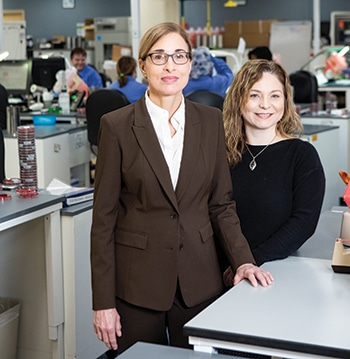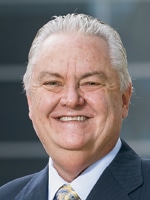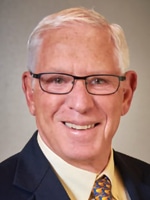Karen Titus
May 2019—When Monica Rocheford and colleagues at Allina Health Laboratory first began digging into rising turnover rates at various locales within the system, the effort carried a whiff of concern, if not urgency. One hospital site had jumped from a 10.8 percent turnover rate in 2016 to 44.9 percent two years later. At another site, turnover reached 49 percent in 2018, from 24 percent the year before.
The culprit appeared to be a three-letter word: pay.
“That was the main reason they were giving us for their resignation,” says Rocheford, system director, laboratory operations, recalling the exit interviews with departing staff. So in 2018, Allina, with nearly 1,000 lab employees (spread across 12 hospitals, a core lab, and roughly 60 clinics in Minnesota and western Wisconsin), awarded a technical increase across the board. Around the same time, most staff received merit increases, thanks to scheduled performance reviews. “So a lot of people got a really nice bump,” including those at the lower end of the pay scale.

Dr. Lauren Anthony (left) and Monica Rocheford at Allina Health Laboratory, where overall turnover has held steady in recent years, owing to efforts to improve employee engagement. “It just furthers our theory that pay, even though it’s important, is not the only thing,” Rocheford says. (Photo courtesy of Jenn Ackerman)
And then? “Six months later people started complaining again about pay,” Rocheford says. It doesn’t take long for new realities—including a better paycheck—to become the norm.
Turnover is often told as a tale of numbers, a case study accompanied by handwringing. But as Rocheford and other adventurers in the field soon find out, the real story is more of an epic. Pay might be one factor in staff turnover, for example, but it isn’t the only one. Labs have to contend with pressures from within and without. A strong economy can wreak havoc on lab operations. So can a bad boss. The real hero may not be a person, but rather a concept.
Little wonder, then, that staff turnover is also a story that still lacks a solid ending.“Everybody’s looking for personnel,” says Stan Schofield, president of the regional laboratory NorDx, which is part of the MaineHealth integrated health care system, based in Portland. “I don’t know of a single lab that doesn’t have vacancies, from entry level all the way to advanced, esoteric testing. You can slice it and dice it in multiple ways. Cytotechs, histotechs, molecular techs, med techs—everybody’s got shortages. Mine’s just a little more extreme, because [Maine] is a semi-rural, cold-weather, high-tax state,” says Schofield, who runs the laboratory service line for the system, overseeing equipment and personnel for a core lab, 10 hospitals, and a large outreach program.
Entry-level positions, such as those in phlebotomy or specimen management, as well as lab assistants (and sometimes couriers) have always had relatively high turnover rates, since these jobs can be a traditional steppingstone to another career, says Schofield. “They work two, three years, and then go off to professional school or graduate school.”
Moreover, Schofield says, phlebotomy has become a tougher job, involving computerized order entry, bedside label printing, and microsampling requirements. Those who work as nonhospital employees, at patient service centers, often have the added complications of patient registration, order verification, insurance verification, and specimen and patient ID, as well as managing the site. Traveling phlebotomists, who collect at nursing homes, have their own challenges as well.
When the economy picks up—as it has in recent years—turnover rates often jump even higher than the norm. A usual 20 percent rate can jump to 25, 30, or even 35 percent. “It takes eight weeks to train them, and two weeks to leave,” says Schofield. His frustration is clear.

Schofield
“If you get into a competitive threat where someone offers a dollar an hour more, you’ll lose several of your workforce until you match the price. So they shop, and they flip from lab to lab, hospital to hospital, trying to drive up salaries.” While not new, says Schofield, “It is now at a critical level,” and has been since 2017. Moreover, even the most reliable employees may leave if an underemployed spouse lands a better job elsewhere.
NorDx has responded by raising wages several times since the economy picked up. “This past year, instead of the usual two or three percent, we had to go with a total market adjustment, for a lot of my lab staff, at 4.4 percent,” Schofield says. “And we’re now contemplating a mid-year increase” to keep pace with what’s happening elsewhere.
An aging workforce also comes into play, says Schofield, who reports retirement rates of seven to eight percent annually. “And nobody’s coming into the field.”
Not without prodding, anyway. “We’ve had to develop a lot of our own educational opportunities and programs here,” he says. They’ve offered MLT and CLT training to those with undergraduate degrees in disciplines such as biology. “That’s helped fill the gaps” created by retirements, relocations, and the strong economy. The unemployment rate in Maine hovers around three percent, Schofield notes.
Even small numbers have a role to play. A recent CAP Q-Probes overseen by David Novis, MD, looked at turnover data from 21 participants. (The study defines turnover as the rate at which workers vacate positions that their employers intend to refill; vacancy refers to the percentage of vacant positions for which businesses are actively recruiting.) While not beefy enough to substantiate trends (“I think I made Q-Probes history by doing the least-subscribed study ever,” he jokes), the results can tender some ideas, he says.The study had two main findings, says Dr. Novis, president of Novis Consulting, Portsmouth, NH. One, laboratories that developed and communicated clear career paths to their employees had less turnover. Two, labs that funded external laboratory continuing medical education also had lower turnover rates.

Dr. Novis
A third point came to light only after the report was written, Dr. Novis says. “Here’s my pearl—here’s my revelation that I wish I’d put in the paper: I don’t think those findings, per se, mean anything.” Instead, he suggests, “The real take-home lesson is, they’re emblematic of a culture that invests in their people.”
In the most stable labs, Dr. Novis continues, everyone understands that people are “the most important pieces of the machinery.” These labs aren’t trying to extract every last bit of work out of their employees; instead, they invest in, and show appreciation for, their employees. “You need to make everyone feel like they’re part of what we’re doing in the lab.”
Dr. Novis cites as an example an interview he had heard in which a former astronaut (now a physician) said that if a visitor to NASA asked janitorial staff what they did, their response was unambiguous: Our job is putting a man in space. That sort of everybody-in thinking should permeate labs as well—those who work on the loading dock aren’t handling boxes, Dr. Novis says; rather, they’re providing a service that, ultimately, helps patients.
Even Dr. Novis wants to feel like part of the team. “I recall in my practice there were doctors like that—those who made you feel a part of things, and those who made you feel like you were merely working for them. In the latter group, it was unpleasant.”
Dr. Novis offers other interesting tidbits, based on his years of experience working with troubled labs. (“Who calls in a consultant when things are going well?” he says with a laugh.) Among them:
• Phlebotomists consistently have the highest rates of turnover. In the Q-Probes study, phlebotomists had the highest median of the three-year (2015–2017) average turnover rates, at 24.9 percent; median turnover rate for all staff was 16.2 percent.
• Phlebotomists and health care CEOs are oddly linked. “It’s interesting—the numbers show that the greatest turnovers are at both ends,” he says (though it’s not because they’re trading places). One recent study put CEO turnover rates at 18 percent.
Dr. Novis’ take on CEO turnover is based on his experience as a former hospital trustee and near-constant membership on a board of some sort—directors, trustees, CAP governors—since 1980. “It takes about three years for the board to decide the CEO walks on water—or doesn’t,” he says.
• Turnover seems to be smallest when hiring local. “I don’t have data on that—it’s just my anecdotal impression,” he says.
He notes that he recently completed a large job for a network of hospitals located in tiny cities and rural areas of the lower Midwest. In talking with employees, he says, he found that nearly all were local. They grew up in the area, had spouses who had done the same, and had family living close by. “They’re probably not going to turn over and move elsewhere,” Dr. Novis says. “Roots seem to be a great anchor.”
Allina has experienced firsthand the steadying power of changing the culture. The overall numbers have held steady between 2016 and 2018, says Rocheford, with turnover hovering around 14 percent (14.4 in 2016, 13.9 in 2017, 14.5 in 2018). Given the dramatic upticks at some sites, turnover should have been dropping elsewhere.Sure enough, it was. One hospital had a lab turnover rate of 22 percent in 2016; in 2017 it dropped to 16.5, and last year was 10.9. At another hospital, the turnover rate went from 36.1 in 2016 to 10.1 in 2018.
“That’s significant,” Rocheford says, adding that the drops were due to the considerable efforts Allina has made in recent years to improve employee engagement, both at specific sites and across the system.
As Rocheford found out when she started looking past pay-related departures, employees also want to feel supported at work, to be part of a cohesive team, to feel challenged, and to see a clear path to professional development. “When you invest in all those things, including pay, that’s when you can make a more significant impact on turnover,” she says.
It turns out that the sites with the biggest turnover were also sites that had been roiled by change. “A lot of change,” Rocheford reports. As a result, the critical elements of team dynamics and feeling supported went missing. “Disengagement then went through the roof,” and employees left. “It just furthers our theory that pay, even though it’s important, is not the only thing.”
Systemwide, Allina has put a number of things in place to improve engagement, including:
• Recognition. This includes a quarterly program—employees nominate one another—that entails a small financial gift as well as public acknowledgment. Allina also uses newsletters to recognize staff. One recent issue reported on a phlebotomist who, while outside getting lunch, was asked by a passerby for directions to the ED. The phlebotomist asked the critical follow-up question: Why was he asking? The person replied he thought he was having a heart attack, at which point the phlebotomist, rather than point him down the street, jumped into the person’s car and drove him around the corner to the ED. Another story involved a phlebotomist who noticed that a lab colleague seemed “off” and asked a nurse to check the person out. It turned out the colleague was having a stroke.
“The newsletter may seem like a silly little thing,” says Rocheford. But she’s convinced the stories, recognition, thank-yous, and accolades help staff feel connected. “It increases the feeling that we’re all one lab, even though we’re spread out across 12 hospital and 60-plus clinic sites.”
• Development. The goal is to support employees in their careers as well as their current jobs.
While that extends to everyone, Rocheford suspects the biggest reward will come from investing in middle management, including laboratory managers and supervisors. “Really, they’re the ones who have the most impact on employee engagement,” she says. “They’re the ones who have the potential to make or break how an employee is feeling about their job. The guidance and support of a strong leader can make a huge difference for an employee.”
Oftentimes managers are promoted because of their technical expertise. “That’s why they get the job, because they’re fantastic at doing what they do,” Rocheford says. But many lack management expertise. “Are they inspiring? Do they have soft skills? Do they talk to their people about development? We know that these skills are absolutely essential.” Hence the current investment in leadership development for this group.
Interest has been high, she says. People want to do these jobs well; they just don’t know how, especially brand-new leaders. These folks are the buffers when change occurs at the top. “They need to be strong themselves,” Rocheford says. “If they’re worried it will affect them, that panic trickles down and affects staff. You want people who can keep calm. People with strong leadership skills can keep the angst at bay.”
Lauren Anthony, MD, system medical director at Allina, agrees that when there’s churn in top leadership, instability spills everywhere. And whenever a major upheaval occurs, people are leery of taking a position that they fear might be eliminated in, say, a restructuring: Are we going to shift direction? Are we going to have different priorities?
• Opportunities, within current jobs and career-wise. “We’ve painted a very accurate picture of all the opportunities that exist within our lab,” says Rocheford.
 CAP TODAY Pathology/Laboratory Medicine/Laboratory Management
CAP TODAY Pathology/Laboratory Medicine/Laboratory Management
